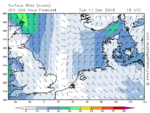Hi folks,
I am currently reading a lot on allied bombing during WWII and was wondering how much bombing (especially of the USAAF and RAF) was dependent on weather conditions. Intuitively, I would think that more wind, for instance, should result in further distances flown by the allies because the wind over Germany usually comes from the West, i.e. tail wind for the allies. However, tail wind might be bad for gaining lift...
I already had a closer look myself at the distances flown in 1943/44 and wind speed and found that higher wind speed seems to go along with less distance. This does not make much sense to me, precisely because the wind over Germany usually comes from the West and therefore should be helpful for allied bombers.
Do you have any explanation for this phenomenon?
Cheers,
J
I am currently reading a lot on allied bombing during WWII and was wondering how much bombing (especially of the USAAF and RAF) was dependent on weather conditions. Intuitively, I would think that more wind, for instance, should result in further distances flown by the allies because the wind over Germany usually comes from the West, i.e. tail wind for the allies. However, tail wind might be bad for gaining lift...
I already had a closer look myself at the distances flown in 1943/44 and wind speed and found that higher wind speed seems to go along with less distance. This does not make much sense to me, precisely because the wind over Germany usually comes from the West and therefore should be helpful for allied bombers.
Do you have any explanation for this phenomenon?
Cheers,
J

